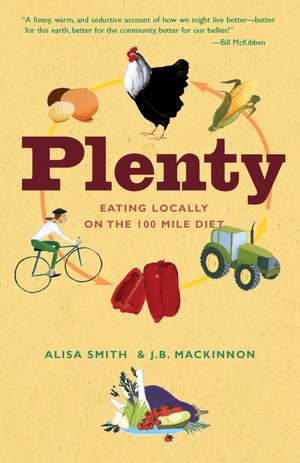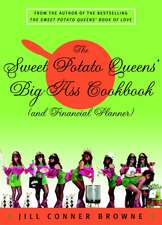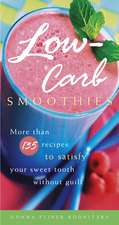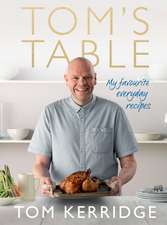Plenty: Eating Locally on the 100-Mile Diet
Autor Alisa Smith, J. B. Mackinnonen Limba Engleză Paperback – 31 mar 2008
When Alisa Smith and James MacKinnon learned that the average ingredient in a North American meal travels 1,500 miles from farm to plate, they decided to launch a simple experiment to reconnect with the people and places that produced what they ate. For one year, they would only consume food that came from within a 100-mile radius of their Vancouver apartment. The 100-Mile Diet was born.
The couple’s discoveries sometimes shook their resolve. It would be a year without sugar, Cheerios, olive oil, rice, Pizza Pops, beer, and much, much more. Yet local eating has turned out to be a life lesson in pleasures that are always close at hand. They met the revolutionary farmers and modern-day hunter-gatherers who are changing the way we think about food. They got personal with issues ranging from global economics to biodiversity. They called on the wisdom of grandmothers, and immersed themselves in the seasons. They discovered a host of new flavours, from gooseberry wine to sunchokes to turnip sandwiches, foods that they never would have guessed were on their doorstep.
The 100-Mile Diet struck a deeper chord than anyone could have predicted, attracting media and grassroots interest that spanned the globe. The 100-Mile Diet: A Year of Local Eating tells the full story, from the insights to the kitchen disasters, as the authors transform from megamart shoppers to self-sufficient urban pioneers. The 100-Mile Diet is a pathway home for anybody, anywhere.
Call me naive, but I never knew that flour would be struck from our 100-Mile Diet. Wheat products are just so ubiquitous, “the staff of life,” that I had hazily imagined the stuff must be grown everywhere. But of course: I had never seen a field of wheat anywhere close to Vancouver, and my mental images of late-afternoon light falling on golden fields of grain were all from my childhood on the Canadian prairies. What I was able to find was Anita’s Organic Grain & Flour Mill, about 60 miles up the Fraser River valley. I called, and learned that Anita’s nearest grain suppliers were at least 800 miles away by road. She sounded sorry for me. Would it be a year until I tasted a pie?
—From The 100-Mile Diet
From the Hardcover edition.
Preț: 90.23 lei
Nou
Puncte Express: 135
Preț estimativ în valută:
17.27€ • 18.77$ • 14.52£
17.27€ • 18.77$ • 14.52£
Carte tipărită la comandă
Livrare economică 21 aprilie-05 mai
Preluare comenzi: 021 569.72.76
Specificații
ISBN-13: 9780307347336
ISBN-10: 0307347338
Pagini: 264
Dimensiuni: 133 x 204 x 15 mm
Greutate: 0.2 kg
Ediția:Reprint
Editura: Three Rivers Press (CA)
ISBN-10: 0307347338
Pagini: 264
Dimensiuni: 133 x 204 x 15 mm
Greutate: 0.2 kg
Ediția:Reprint
Editura: Three Rivers Press (CA)
Notă biografică
Alisa Smith, a Vancouver-based freelance writer who has been nominated for a National Magazine Award, has been published in Outside, Explore, Canadian Geographic, Reader’s Digest, Utne, and many other periodicals. The books Way Out There and Liberalized feature her work.
J.B. MacKinnon is the author of Dead Man in Paradise, which won the 2006 Charles Taylor Prize for Literary Non-fiction. His feature reportage on issues ranging from African prisons to anarchism in America has earned three National Magazine Awards.
From the Hardcover edition.
J.B. MacKinnon is the author of Dead Man in Paradise, which won the 2006 Charles Taylor Prize for Literary Non-fiction. His feature reportage on issues ranging from African prisons to anarchism in America has earned three National Magazine Awards.
From the Hardcover edition.
Extras
Herb Tea
1 leaf sage
1 leaf mint
hot water
Place the fresh-picked leaves in a mug. Add water at a rolling boil. Steep for 6 minutes. A simple beginning.
March
Man is born free and everywhere is in chain stores.
graffiti
The year of eating locally began with one beautiful meal and one ugly statistic.
First, the meal. What we had on hand, really, was a head of cabbage. Deep inside its brainwork of folds it was probably nourishing enough, but the outer layers were greasy with rot, as though the vegetable were trying to be a metaphor for something. We had company to feed, and a three-week-old cabbage to offer them.
It wasn’t as though we could step out to the local megamart. We—Alisa and I—were at our “cottage” in northern British Columbia, more honestly a drafty, jauntily leaning, eighty-year-old homestead that squats in a clearing between Sitka spruce and western redcedar trees large enough to crush it into splinters with the sweep of a limb. The front door looks out on a jumble of mountains named after long-forgotten British lords, from the peaks of which you can see, just to the northwest, the southern tip of the Alaska Panhandle. There is no corner store here. In fact, there is no electricity, no flush toilet, and no running water but for the Skeena River rapids known as the Devil’s Elbow. They’re just outside the back door. Our nearest neighbor is a black bear. There are also no roads. In fact, the only ways in or out are by canoe, by foot over the distance of a half-marathon to the nearest highway, or by the passenger train that passes once or twice a day, and not at all on Tuesdays. So: we had a cabbage, and a half-dozen mouths to feed for one more autumn evening. Necessity, as they say, can be a mother.
I can’t remember now who said what, or how we made the plan, or even if we planned it at all. What I know is that my brother David, a strict vegetarian, hiked to the mouth of Fiddler Creek, which straight-lines out of a bowl of mountains so ancient they make you feel perpetually reborn, and reeled in an enormous Dolly Varden char. Our friends Kirk and Chandra, who are the sort of people who can tell a Bewick’s wren from a rufous-crowned sparrow by ear, led a party into the forest and returned with pound upon pound of chanterelle, pine, and hedgehog mushrooms. I rooted through the tall grass to find the neglected garden plot where, months earlier, we had planted garlic and three kinds of potato; each turned up under the spade, as cool and autonomous as teenagers. Alisa cut baby dandelion leaves, while her mother picked apples and sour cherries from an abandoned orchard, and rose hips from the bushes that were attempting to swallow the outhouse. The fruit we steeped in red wine—all right, the wine came from Australia. Everything else we fried on the woodstove, all in a single huge pan.
It was delicious. It was a dinner that transcended the delicate freshness of the fish, the earthy goodness of the spuds that had sopped up the juices of mushrooms and garlic. The rich flavors were the evening’s shallowest pleasure. We knew, now, that out there in the falling darkness the river and the forest spoke a subtle language we had only begun to learn. It was the kind of meal that, when the plates were clean, led some to dark corners to sleep with the hushing of the wind, and others to drink mulled wine until our voices had climbed an octave and finally deepened, in the small hours, into whispers. One of the night’s final questions, passed around upon faces made golden by candlelight: Was there some way to carry this meal into the rest of our lives?
A week later we were back in our one-bedroom apartment in Vancouver, surrounded by two million other people and staring out the sitting-room window. We have a view of a parking lot and two perpetually overloaded Dumpsters. It was as good a place as any to contemplate the statistic. The number just kept turning up: in the reports that Alisa and I read as journalists; in the inch-long news briefs I’ve come to rely on as an early-warning system for stories that would, in a few months or a few years, work their way into global headlines. According to the Leopold Center for Sustainable Agriculture at Iowa State University, the food we eat now typically travels between 1,500 and 3,000 miles from farm to plate. The distance had increased by up to 25 percent between 1980 and 2001, when the study was published. It was likely continuing to climb.
I didn’t know any more about it than that. It was enough. Like so many other people, Alisa and I had begun to search for ways to live more lightly in an increasingly crowded and raggedy-assed world. There is no shortage of information about this bright blue planet and its merry trip to hell in a hand- basket, and we had learned the necessary habit of shrugging off the latest news bites about “dead zones” in the Gulf of Mexico or creatures going extinct after 70 million years—70 million years—on Earth. What we could not ignore was the gut feeling, more common and more important than policy makers or even scientists like to admit, that things have gone sideways. That the winter snow is less deep than it was when we were children, the crabs fewer under the rocks by the shore, the birds at dawn too quiet, the forest oddly lonesome. That the weather and seasons have become strangers to us. And that we, the human species, are in one way or another responsible. Not guilty, but responsible.
The gut feeling affects people. I received a letter once, as a journalist, from a young man who had chained himself to a railing in a mall on the biggest shopping day of the year in America, the Saturday after Thanksgiving, and set himself on fire to protest rampant consumerism. He survived, barely, and was ordered into mental health care, but all of his opinions were of a kind commonly held by some of the most lucid and admired ecologists and social theorists of our times. A friend of mine, a relationship counselor, told me of a couple whose marriage was being tested by a disagreement over the point at which the world’s reserves of cheap petroleum will surpass maximum production and begin to decline. Concerned for his child’s future in an “end of oil” scenario, the husband, an otherwise typical health-care provider, wanted to go bush, learn how to tan buckskins, teach their boy to hunt and forage. The wife, equally concerned for the child, preferred everyday life in a society where carbonated soda is the leading source of calories in the diet of the average teenager and the New England Journal of Medicine reports that, owing to obesity and physical inactivity, the life spans of today’s children may be shorter than those of their parents. So who’s crazy?
A more typical response is the refusal to purchase an enormous, fuel-inefficient SUV. Alisa and I had made that choice. Yet, as the Leopold Center numbers seemed to suggest, we had no cause to feel holier-than-thou. Each time we sat down to eat, we were consuming products that had traveled the equivalent distance of a drive from Toronto, Ontario, to Whitehorse, Yukon Territory, or from New York City to Denver, Colorado. We were living on an SUV diet.
“I think we should try eating local food for a year.”
We were at the breakfast table when these words came out of my mouth. Alisa did not look up at me as though I were insane. We had begun to do these kinds of things, insuring the car in the summer only and getting through the winter by bicycle; or living part of each year in a northern hideaway where the “emergency procedure” was to wave your arms in front of a passing freight train and then sit tight and wait—the following train was the one that would stop.
Besides, I do all the cooking.
Alisa had a pensive look on her face. “It might not even be possible,” she said. A long pause settled between us. “What about sugar?”
She knew immediately, I think, that she had lost the argument. What about sugar? Well, I had learned one or two things about sugar over the previous year, while researching a book set in the Dominican Republic. The journey had taken me through the bateys, the shanties inhabited by mainly ethnic Haitian sugar workers, certainly some of the world’s poorest people. One afternoon I went out with a nun to pick up an elderly cane-cutter; there was a space for him in the old folks’ home that had been set up by the Catholic sisters. We drove past walls of green cane stalks to a clearing with patched-together tin shelters and one-room concrete shacks. The man was leaning against a wall, literally holding himself together with his hands. He had worked so hard and for so long that his hip socket had worn out, and he could not walk without pressing the femur into place. I carried his bag, which contained everything he had to show for a lifetime of labor. It was a schoolchild’s backpack, with a broken zipper. Staring out at the men cutting cane as we departed, he said into the air, “Hungry. I’ve been hungry all these years.”
I had taken on the irritating habit, whenever Alisa came to me with some complaint that I considered overly modern and urban, such as the effects of rainfall on suede or a pinched nerve from talking too long on the phone, of saying that I would make sure to let them know all about it in the bateys.
I arched an eyebrow in Alisa’s direction. The question of sugar was a reminder of why I wanted to try this local-eating experiment in the first place. It isn’t only that our food is traveling great distances to reach us; we, too, have moved a great distance from our food. This most intimate nourishment, this stuff of life—where does it come from? Who produces it? How do they treat their soil, crops, animals? How do their choices—my choices—affect my neighbors and the air, land, and water that surround us? If I knew where my food and drink came from, would I still want to eat it? If even my daily bread has become a mystery, might that total disconnection be somehow linked to the niggling sense that at any moment the apocalyptic frogs might start falling from the sky?
“We’ll use honey,” I said to Alisa.
“Yeah,” she replied doubtfully. “Honey.”
From the Hardcover edition.
1 leaf sage
1 leaf mint
hot water
Place the fresh-picked leaves in a mug. Add water at a rolling boil. Steep for 6 minutes. A simple beginning.
March
Man is born free and everywhere is in chain stores.
graffiti
The year of eating locally began with one beautiful meal and one ugly statistic.
First, the meal. What we had on hand, really, was a head of cabbage. Deep inside its brainwork of folds it was probably nourishing enough, but the outer layers were greasy with rot, as though the vegetable were trying to be a metaphor for something. We had company to feed, and a three-week-old cabbage to offer them.
It wasn’t as though we could step out to the local megamart. We—Alisa and I—were at our “cottage” in northern British Columbia, more honestly a drafty, jauntily leaning, eighty-year-old homestead that squats in a clearing between Sitka spruce and western redcedar trees large enough to crush it into splinters with the sweep of a limb. The front door looks out on a jumble of mountains named after long-forgotten British lords, from the peaks of which you can see, just to the northwest, the southern tip of the Alaska Panhandle. There is no corner store here. In fact, there is no electricity, no flush toilet, and no running water but for the Skeena River rapids known as the Devil’s Elbow. They’re just outside the back door. Our nearest neighbor is a black bear. There are also no roads. In fact, the only ways in or out are by canoe, by foot over the distance of a half-marathon to the nearest highway, or by the passenger train that passes once or twice a day, and not at all on Tuesdays. So: we had a cabbage, and a half-dozen mouths to feed for one more autumn evening. Necessity, as they say, can be a mother.
I can’t remember now who said what, or how we made the plan, or even if we planned it at all. What I know is that my brother David, a strict vegetarian, hiked to the mouth of Fiddler Creek, which straight-lines out of a bowl of mountains so ancient they make you feel perpetually reborn, and reeled in an enormous Dolly Varden char. Our friends Kirk and Chandra, who are the sort of people who can tell a Bewick’s wren from a rufous-crowned sparrow by ear, led a party into the forest and returned with pound upon pound of chanterelle, pine, and hedgehog mushrooms. I rooted through the tall grass to find the neglected garden plot where, months earlier, we had planted garlic and three kinds of potato; each turned up under the spade, as cool and autonomous as teenagers. Alisa cut baby dandelion leaves, while her mother picked apples and sour cherries from an abandoned orchard, and rose hips from the bushes that were attempting to swallow the outhouse. The fruit we steeped in red wine—all right, the wine came from Australia. Everything else we fried on the woodstove, all in a single huge pan.
It was delicious. It was a dinner that transcended the delicate freshness of the fish, the earthy goodness of the spuds that had sopped up the juices of mushrooms and garlic. The rich flavors were the evening’s shallowest pleasure. We knew, now, that out there in the falling darkness the river and the forest spoke a subtle language we had only begun to learn. It was the kind of meal that, when the plates were clean, led some to dark corners to sleep with the hushing of the wind, and others to drink mulled wine until our voices had climbed an octave and finally deepened, in the small hours, into whispers. One of the night’s final questions, passed around upon faces made golden by candlelight: Was there some way to carry this meal into the rest of our lives?
A week later we were back in our one-bedroom apartment in Vancouver, surrounded by two million other people and staring out the sitting-room window. We have a view of a parking lot and two perpetually overloaded Dumpsters. It was as good a place as any to contemplate the statistic. The number just kept turning up: in the reports that Alisa and I read as journalists; in the inch-long news briefs I’ve come to rely on as an early-warning system for stories that would, in a few months or a few years, work their way into global headlines. According to the Leopold Center for Sustainable Agriculture at Iowa State University, the food we eat now typically travels between 1,500 and 3,000 miles from farm to plate. The distance had increased by up to 25 percent between 1980 and 2001, when the study was published. It was likely continuing to climb.
I didn’t know any more about it than that. It was enough. Like so many other people, Alisa and I had begun to search for ways to live more lightly in an increasingly crowded and raggedy-assed world. There is no shortage of information about this bright blue planet and its merry trip to hell in a hand- basket, and we had learned the necessary habit of shrugging off the latest news bites about “dead zones” in the Gulf of Mexico or creatures going extinct after 70 million years—70 million years—on Earth. What we could not ignore was the gut feeling, more common and more important than policy makers or even scientists like to admit, that things have gone sideways. That the winter snow is less deep than it was when we were children, the crabs fewer under the rocks by the shore, the birds at dawn too quiet, the forest oddly lonesome. That the weather and seasons have become strangers to us. And that we, the human species, are in one way or another responsible. Not guilty, but responsible.
The gut feeling affects people. I received a letter once, as a journalist, from a young man who had chained himself to a railing in a mall on the biggest shopping day of the year in America, the Saturday after Thanksgiving, and set himself on fire to protest rampant consumerism. He survived, barely, and was ordered into mental health care, but all of his opinions were of a kind commonly held by some of the most lucid and admired ecologists and social theorists of our times. A friend of mine, a relationship counselor, told me of a couple whose marriage was being tested by a disagreement over the point at which the world’s reserves of cheap petroleum will surpass maximum production and begin to decline. Concerned for his child’s future in an “end of oil” scenario, the husband, an otherwise typical health-care provider, wanted to go bush, learn how to tan buckskins, teach their boy to hunt and forage. The wife, equally concerned for the child, preferred everyday life in a society where carbonated soda is the leading source of calories in the diet of the average teenager and the New England Journal of Medicine reports that, owing to obesity and physical inactivity, the life spans of today’s children may be shorter than those of their parents. So who’s crazy?
A more typical response is the refusal to purchase an enormous, fuel-inefficient SUV. Alisa and I had made that choice. Yet, as the Leopold Center numbers seemed to suggest, we had no cause to feel holier-than-thou. Each time we sat down to eat, we were consuming products that had traveled the equivalent distance of a drive from Toronto, Ontario, to Whitehorse, Yukon Territory, or from New York City to Denver, Colorado. We were living on an SUV diet.
“I think we should try eating local food for a year.”
We were at the breakfast table when these words came out of my mouth. Alisa did not look up at me as though I were insane. We had begun to do these kinds of things, insuring the car in the summer only and getting through the winter by bicycle; or living part of each year in a northern hideaway where the “emergency procedure” was to wave your arms in front of a passing freight train and then sit tight and wait—the following train was the one that would stop.
Besides, I do all the cooking.
Alisa had a pensive look on her face. “It might not even be possible,” she said. A long pause settled between us. “What about sugar?”
She knew immediately, I think, that she had lost the argument. What about sugar? Well, I had learned one or two things about sugar over the previous year, while researching a book set in the Dominican Republic. The journey had taken me through the bateys, the shanties inhabited by mainly ethnic Haitian sugar workers, certainly some of the world’s poorest people. One afternoon I went out with a nun to pick up an elderly cane-cutter; there was a space for him in the old folks’ home that had been set up by the Catholic sisters. We drove past walls of green cane stalks to a clearing with patched-together tin shelters and one-room concrete shacks. The man was leaning against a wall, literally holding himself together with his hands. He had worked so hard and for so long that his hip socket had worn out, and he could not walk without pressing the femur into place. I carried his bag, which contained everything he had to show for a lifetime of labor. It was a schoolchild’s backpack, with a broken zipper. Staring out at the men cutting cane as we departed, he said into the air, “Hungry. I’ve been hungry all these years.”
I had taken on the irritating habit, whenever Alisa came to me with some complaint that I considered overly modern and urban, such as the effects of rainfall on suede or a pinched nerve from talking too long on the phone, of saying that I would make sure to let them know all about it in the bateys.
I arched an eyebrow in Alisa’s direction. The question of sugar was a reminder of why I wanted to try this local-eating experiment in the first place. It isn’t only that our food is traveling great distances to reach us; we, too, have moved a great distance from our food. This most intimate nourishment, this stuff of life—where does it come from? Who produces it? How do they treat their soil, crops, animals? How do their choices—my choices—affect my neighbors and the air, land, and water that surround us? If I knew where my food and drink came from, would I still want to eat it? If even my daily bread has become a mystery, might that total disconnection be somehow linked to the niggling sense that at any moment the apocalyptic frogs might start falling from the sky?
“We’ll use honey,” I said to Alisa.
“Yeah,” she replied doubtfully. “Honey.”
From the Hardcover edition.
Recenzii
This very human and often humorous adventure about two people eating food grown within a short distance of their home is surprising, delightful, and even shocking. If you’ve only talked about eating locally but never given yourself definitions—especially strict ones—to follow, I assure you that your farmers’ market will never again look the same. Nothing you eat will look the same! This inspiring and enlightening book will give you plenty to chew on.”
—Deborah Madison, author of Local Flavors: Cooking and Eating from America’s Farmers’ Markets
“Plenty posits a brilliant, improbable, and finally deliciously noble notion of connecting to the world by striving first to understand what’s underfoot. Beautifully written and lovingly paced, it is at once a lonely and uplifting tale of deep respect between two people, their community, and our earth. Plenty will change your life even if you never could or would try this at home.”
—Danny Meyer, author of Setting the Table
“A funny, warm, and seductive account of how we might live better—better for this earth, better for the community, better for our bellies!”
—Bill McKibben, author of Deep Economy: The Wealth of Communities and the Durable Future
“Engaging, thoughtful…packed with natural, historical and personal detail.”--Liesel Schillinger, The New York Times
“Succeeds because Smith and MacKinnon don’t give a ____about being normal. Locavorism isn’t normal—that’s the point—and they fly their freak flag with bemused pride, giving themselves over to the mania that infects the newly converted….One imagines Kingsolver at home on her sturdy homestead shaking her head and clucking at those ‘trendy’ kids, but they’re the ones I’d rather have dinner with.”--Martha Bayne, Chicago Reader
—Deborah Madison, author of Local Flavors: Cooking and Eating from America’s Farmers’ Markets
“Plenty posits a brilliant, improbable, and finally deliciously noble notion of connecting to the world by striving first to understand what’s underfoot. Beautifully written and lovingly paced, it is at once a lonely and uplifting tale of deep respect between two people, their community, and our earth. Plenty will change your life even if you never could or would try this at home.”
—Danny Meyer, author of Setting the Table
“A funny, warm, and seductive account of how we might live better—better for this earth, better for the community, better for our bellies!”
—Bill McKibben, author of Deep Economy: The Wealth of Communities and the Durable Future
“Engaging, thoughtful…packed with natural, historical and personal detail.”--Liesel Schillinger, The New York Times
“Succeeds because Smith and MacKinnon don’t give a ____about being normal. Locavorism isn’t normal—that’s the point—and they fly their freak flag with bemused pride, giving themselves over to the mania that infects the newly converted….One imagines Kingsolver at home on her sturdy homestead shaking her head and clucking at those ‘trendy’ kids, but they’re the ones I’d rather have dinner with.”--Martha Bayne, Chicago Reader
Descriere
"Plenty" tells the remarkable adventures of a Canadian couple who make a year-long attempt to eat foods grown and produced within a 100-mile radius of their apartment--and learn the simple joys of reconnecting with community and home ground in the process.









